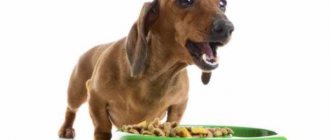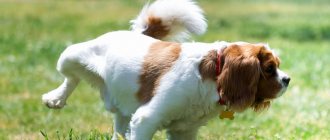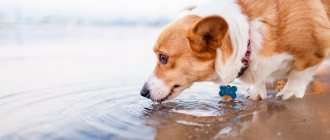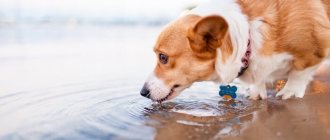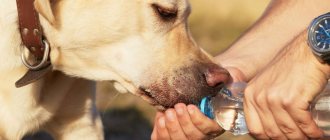In the summer heat or in a too warm room, a dog may suddenly increase the amount of fluid it consumes to quench its thirst. Naturally, she will begin to ask to go outside more often to urinate. There is nothing surprising or dangerous about this.
It is equally normal for thirst to appear after eating specific salty foods, for example, if a dog ate a piece of salted fish or smoked sausage, as well as after increased physical exertion. Thirst also increases after castration, as well as during breastfeeding, especially with large numbers of puppies.
It's a completely different matter if the animal suddenly starts drinking too much water for no apparent reason. This may be one of the first signs of a developing disease, which is important not to miss. In this case, treating the dog will be much easier and faster, and cheaper too.
Causes of the disease
There may be several pathological reasons for increased thirst:
- Treatment with diuretics, anticonvulsants and corticosteroids. In this case, increased water consumption is normal, and there is no need to limit the animal’s fluid intake.
- An inflammatory process in the body, which is accompanied by an increase in body temperature.
- Disorders of the kidneys and urinary system. In this case, the animal urinates frequently and drinks a lot of water in an attempt to restore electrolyte balance. Urolithiasis is especially dangerous because it can lead to blockage of the ureter or urethra with a stone, which will lead to the development of a severe pain attack. The cessation of urine excretion causes uremia and poisoning of the body with waste products. Treatment of urolithiasis in dogs with folk remedies is unacceptable; at the first suspicion, you should immediately contact a veterinarian without wasting time.
- Diabetes of the first and second types. This is a very dangerous disease, which is often accompanied by increased thirst.
- Pyometra is a purulent inflammation of the internal cavity of the uterus.
- Piroplasmosis, caused by protozoa, is also accompanied by increased thirst.
- Polydipsia of psychogenic origin provokes an increase in water consumption.
- Some types of spinal injuries, for example, pinched nerve endings, in some cases provoke an increase in thirst.
Not in all cases it is possible to easily determine the reason why the dog began to drink much more liquid. Therefore, if natural reasons for increased drinking of water are excluded, this condition should alarm the animal owner and become a reason for a visit to the veterinary clinic.
Causes of increased thirst in dogs
The causes of increased thirst in dogs can be natural or pathological.
First, let's figure out why a dog should drink regularly:
- Restoration of water-salt and water-electrolyte balances in the body.
- Maintaining the functioning of the hematopoietic system.
- Maintaining metabolic function.
The first reason determines literally all processes associated with the exchange of water in the body. Water-salt and water-electrolyte balance allows the body to produce enough fluid where it is needed.
With a lack of water in the body, the first noticeable damage occurs to the hematopoietic system and metabolism - the dog’s metabolism slows down and the blood thickens, resulting in oxygen starvation of tissues and organs.
Which breeds are more susceptible
Representatives of any breed can show signs of pathological thirst. Dogs that are “hairless” or have a very short, “plush” coat drink more water, as they are more exposed to environmental influences. They are also more susceptible to colds due to hypothermia, so they are more likely than others to suffer from rising temperatures and kidney problems.
In animals with short legs and a long spine, pinched nerve roots are more likely to occur, which can also cause thirst. These are mainly dachshunds, basset hounds, English and French bulldogs and other breeds.
Diagnosis at the veterinarian
After examination, a general and chemical blood test must be taken from the four-legged patient. All other studies are prescribed individually, based on the overall picture. These may include:
- clinical and bacteriological analysis of urine;
- Ultrasound;
- X-ray;
- CT and MRI;
- washes and smears.
After receiving all the results, the veterinarian determines the exact reason why the dog drinks water frequently. Based on this, further treatment is selected.
Main symptoms
An experienced owner will immediately notice if the animal begins to drink much more than usual. Additionally, the following signs of trouble may be noted:
- Lack of appetite or complete refusal to eat.
- Lethargy, weakness, apathetic state.
- The dog stops playing, hides under furniture, and does not respond to its owners.
- She has a dry nose, hot ears, and her eyes may become inflamed.
- When trying to urinate, the dog whines, and blood and/or sand, mucus, and pus are noticeable in the urine.
- The animal has suddenly lost weight or, conversely, gained excessive weight without increasing or decreasing the standard food intake.
If signs of illness appear, you need to check whether the dog’s food is oversalted and ensure that the animal is not overheated. If everything is fine with this, the dog needs to be taken to the clinic urgently.
Prevention
To prevent possible diseases, you need:
- carefully monitor the dog’s condition;
- provide her with the amount of water she needs;
- monitor the quality of food; if you feed natural food, ensure a balanced diet;
- Visit your veterinarian periodically to check your pet's health.
Diagnostics in a veterinary clinic
The veterinarian will examine the dog and send it for blood and urine tests, an ultrasound, and, if necessary or if spinal damage is suspected, for x-rays. In complex cases, it may be necessary to undergo a computed tomography or magnetic resonance imaging scan to clarify the problem and its localization.
Consequences of not drinking
If your dog is eating but not getting enough water, this can lead to a number of serious problems. Possible consequences:
- decreased activity, lethargy and lethargy;
- change in skin tone;
- deterioration of joint function, pain when walking;
- disruption of the functioning of all internal organs;
- slowing down metabolism;
- departure against the background of stagnation of toxins in the body;
- development of chronic diseases.
A prolonged absence of water leads to severe exhaustion of the animal. If the necessary measures are not taken in time, this can result in death. This is why it is important to respond to signs of dehydration as quickly as possible, especially if you have an older dog.
Treatment method and prognosis
The method of treatment depends entirely on what disease caused the development of the disease. If these are kidney problems, they can be treated with medication, and if there is urinary tract obstruction due to stones, bougienage, ultrasonic stone breaking, or surgery may be required.
If nerve endings are pinched, treatment can also be conservative or surgical. In any case, surgery is the last resort, as, for example, with advanced pyometra, when it is not possible to save the inflamed uterus and you have to remove it.
The treatment method and medications used are selected by the attending veterinarian depending on the type and complexity of the disease. If diabetes is the cause of thirst, in addition to treatment, the dog’s owners will have to completely reconsider its menu and their attitude towards feeding the animal.
First of all, you will have to abandon the practice of feeding him from your table with foods that are not suitable for dogs - sweets, baked goods, fatty meats, smoked meats and pickles.
Normal amount of water consumed by a dog
According to existing standards, it is enough for dogs to receive 50-100 ml of fluid per kilogram of weight.
In addition, the amount of water a dog consumes depends on:
- Gender of the dog. Males consume less liquid in their diet.
- Dog breeds. Large breed dogs drink more water than small breed dogs.
- Seasons. During the summer, dogs consume more water.
- Type of feeding. When feeding natural food, the dog receives up to 60-80% liquid in it, when dry feeding - 8-12%.
- The age of the dog. Young dogs consume more fluids than adult dogs for normal organ function.
What to do at home
A sick animal should be provided with a calm, quiet and warm place, protected from drafts, out of the reach of small children and other pets. You need to give your dog plenty of water, or whatever the vet says. If she urinates on herself, you will have to use diapers.
Medicines are given strictly as prescribed by the doctor, without trying to treat the dog yourself. It is especially dangerous to give your dog medications intended for humans.
The water given to the animal must be clean and boiled. It must be changed regularly and the dishes must be washed thoroughly.
The diet needs to be checked and foods that can provoke and stimulate thirst should be excluded. If excessive water consumption is caused by switching the dog exclusively to dry food, it is necessary to provide it with constant fresh drinking water in large quantities.
You can feed the animal as usual if it is not sick and the cause of thirst was not the food itself. If there is a disease, you need to make sure that it is easy for the dog to eat food, if necessary, grind it more or even put it through a meat grinder.
The most important thing a dog needs during illness is the attention and love of its owners, so spend more time on it. This will help you recover faster.
What should the owner do?
The main task of the owner is to eliminate the factor that provokes polydipsia. In case of pathology, the pet is given special medications and a therapeutic diet. In all other cases, it is enough to simply change the conditions of detention and adjust the existing diet.
Begin treatment under the guidance of a veterinarian
The method of treatment depends entirely on the disease. The animal may be prescribed antibiotics, anthelmintics, hepatoprotectors, hormonal or other drugs, as well as gastric lavage, infusion therapy or emergency surgery.
If your pet is diabetic, your pet will need insulin injections for life. This is the only way he can avoid relapses and live a full life.
Take your pet for a walk more often
Frequent and active walks will help avoid obesity. Excess weight puts a lot of stress on internal organs, impairing their functionality. For this reason, the couch lifestyle should not be encouraged.
Provide comfortable living conditions
It is necessary to take care of a sufficient level of humidity, comfortable temperature and cleanliness. It is recommended to place your pet's sleeping place away from drafts and tiled floors to reduce the likelihood of developing a cold.
Put the animal on a diet
The therapeutic diet is selected by the veterinarian based on the diagnosis. The easiest way is to switch to a special line of dry food.
When eating a natural diet, you should limit your salt intake and exclude all prohibited foods. Before recovery, it is better to serve food in ground form to reduce the load on the gastrointestinal tract.
Possible complications
Depending on what disease triggered the thirst attack, complications can be dangerous and even fatal. Especially dangerous are calculi (stones) in the kidneys and pinched nerves in the spine, as well as pyometra.
Stones threaten to block the ureter or urethra, which can lead to an attack of severe pain and the development of very serious complications, including kidney failure or damage to the ureter by the sharp edges of the stone. This can be fatal.
Pinched nerves and displacement of intervertebral discs can lead to complete or partial paralysis and disability of the animal. He will need special conditions or the dog will not survive such a complication.
With pyometra, there is a powerful source of inflammation in the dog’s body. Pus can enter other organs, leading to their infection and the development of an inflammatory process. The most negative diagnosis is sepsis, or general blood poisoning. If the condition is neglected, you may not have time to save your pet.
When thirst is a sign of ill health
Dogs often drink water from a bowl due to significant health problems. The owner should be on alert if thirst is accompanied by any alarming symptoms. Now it’s time to consider when polydipsia is caused by serious problems in the body’s functioning:
- Oncological processes
- in addition to thirst, the dog may also experience stool upset, vomiting, weight loss, loss of appetite, weakness, unpleasant odor from the mouth, discharge from the noose in bitches (if the genitourinary system is affected), apathy; - Diabetes mellitus
- with such a malfunction, dogs not only drink a lot, but also pee a lot, rapidly gain weight (their appetite in diabetes is usually “brutal”), often suffer from vomiting, and lose vision as a result of the development of cataracts; - Diabetes insipidus
- with this disease, in addition to thirst, dogs suffer from low body temperature, experience gastrointestinal disorders, eat little, lose weight, experience pressure surges, and skin problems; - Liver diseases
(liver failure, hepatitis, cholangitis, etc.) – with such ailments, the dog can also drink frequently. In addition, the following symptoms indicate improper liver function: sagging abdomen against the background of ascites, jaundice, gray-white stool, dark-colored urine, frequent urination, pain in the abdominal area; - Kidney diseases
(nephrosis, pyelonephritis, glomerulonephritis, etc.) – the need to absorb large amounts of fluid is often observed with kidney problems. The owner needs to be wary if the dog has cases of urinary incontinence, if the color of the urine is dark or there are blood, purulent or mucous impurities in it, if the animal experiences discomfort when urinating, refuses food or eats very little; - Poisoning
– Your dog may feel unwell, vomit, have an upset stomach, and want to drink water frequently if it has ingested any bad food. In more serious poisonings, the following symptoms may occur: extreme agitation or apathy, increased pulse, fever, convulsions, excessive salivation, diarrhea, change in the color of the mucous membranes (from almost white to blood-red); - Inflammation of the uterus
(pyometra) in bitches - unfortunately, the symptoms of uterine inflammation are similar to those observed with bacterial or viral infections, therefore it is impossible to accurately determine the cause of extreme thirst without the help of an intelligent doctor. With pyometra, animals are lethargic, they often feel sick and have diarrhea. Bitches with this disease may have a stomach ache, and the temperature fluctuates from high to low; - Hypercalcemia
– Puppies receiving more calcium than normal may experience not only thirst, but also poor appetite. In addition, hypercalcemia may cause growth problems and limb deformities; - High temperature
- this symptom, coupled with severe thirst, can be present with many diseases: problems with the thyroid gland, viral or bacterial infections.
Injuries
It happens that frequent urination occurs due to pathologies of the spinal column. They are characterized by injury to nerve endings or the spinal canal. It is almost impossible to cure this, at least completely. Usually dogs with an elongated spine suffer from this, for example, dachshunds.
During or after whelping, these dogs sometimes experience nerve compression. This phenomenon is characterized by lethargy of the animal, lack of strength in the paws, and refusal of its own puppy. The doctor will be able to prescribe a combination treatment after diagnosis.
If the doctor insists on surgery, you should not agree right away; let him conduct special tests and prescribe medications.
Thirst is a normal reaction of the body
I will list some circumstances due to which thirst becomes a natural reaction of the dog’s body. That is, this should not be a cause for concern.
- Season:
On hot summer days, when the air temperature rises, water helps to avoid overheating of the body and maintain normal physical activity of the dog. I recommend that you read about how to protect your dog in the heat.
- Apartment maintenance:
This problem is especially relevant in the winter months, when heating devices are constantly running in the room. Dry air can irritate the mucous membranes of the respiratory tract, as a result of which the dog strives to replenish the lack of moisture in the body.
- Ecological situation:
If you live in a large industrial city with a difficult environmental situation, the cause of thirst may be emissions of pollutants into the atmosphere.
- Power type:
Many dog owners, when switching their pet from dry food to natural food, complain that the dog does not touch water at all. But in this case there is no need to worry about this at all.
If the dog eats natural food, then when calculating the daily moisture intake, all types of liquid are taken into account: kefir, yogurt, broth and even vegetables and meat. When feeding natural food, the animal can obtain the main amount of fluid necessary for the body from food.
For a dog that eats exclusively dry food, the daily water intake increases greatly. The reason lies in the fact that dry food contains from 8 to 12% moisture, while natural food contains 60-80%.
But this does not mean that if you feed your pet natural products, water should be given only occasionally.
Regardless of the type of food, the dog should always have a bowl of clean water.
- Low protein content in food and taking medications provokes increased urine output, which causes physiological thirst.
- Salty or sweet food: if something particularly salty (over-salted broth, porridge, dried meat) gets into your four-legged diet by accident (or not by accident), or your children secretly feed your pet sweets, then the need for high-quality water will increase by 25 - 40%.
- Consequence of anesthesia: thirst after anesthesia is normal. This way the body gets rid of toxins and chemicals. But in this situation, strict control over the amount of water consumed is necessary. Give water little by little and in small portions to protect the kidneys from overload.
- Age and physical activity: Water is an important component for the renewal of blood cells and the removal of toxins from the body. The more active and younger the animal, the more active its metabolism is, and the more water the body requires.
For this reason, due to active metabolism, puppies drink more. But old animals drink a lot, but in small portions, since the body retains moisture less well and requires constant replenishment.
- Estrus: Bitches drink more water per day than males, especially during heat. The constant process of increased blood and urine formation provokes increased thirst.
- Body structure: large muscle mass or abundant fat requires more fluid reserves.
- Coat length: a thick coat always warms well, which means the body will have to be cooled with cool, fresh water.
- Pregnancy and lactation: pregnant and lactating (nursing) dogs need more water, because in the first case they need to provide moisture to both their body and the body of growing babies, who receive moisture through the placenta. In the second case, small puppies receive the moisture they need only with the milk of their mother dog. Bitches with false pregnancies may also consume more water.
If a puppy pees
If your puppy urinates frequently, don't scold him. After all, only at 3-4 months will he be able to learn to control this process. The training period may increase if the owner of the four-legged friend cannot correctly explain when and how to do this to the puppy. It is necessary to suggest where to relieve yourself.
If the puppy is already six months old, and he continues to urinate, then you need to think about the seriousness of the situation - perhaps your pet is simply sick, or maybe he has bad heredity. And if this is the reason, then only surgery will help him.
Diagnosis of the cause of increased water consumption
Your veterinarian will perform several laboratory tests to determine what condition is causing the increased water intake. Each will require a blood chemistry panel that will evaluate major organ systems and electrolytes.
They will also do a complete blood count, which will measure the number of red and white blood cells, as well as a complete urinalysis. The table below provides a description of what is used to determine the correct state.
| What your veterinarian will appreciate | |
| Conditions | Testing to Diagnose an Associated Condition |
| Kidney disease | Elevated kidney values (BUN and Creat), low specific gravity of urine |
| Diabetes | Increased blood glucose levels, glucose in urine |
| Cushing's syndrome | Increased alkaline phosphatase in the liver, changes in the number of leukocytes, increased cholesterol levels. |
| Dehydration | Positive skin turgor, elevated liver protein (albumin), electrolyte changes |
<





